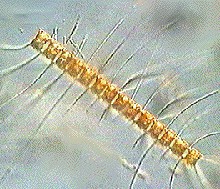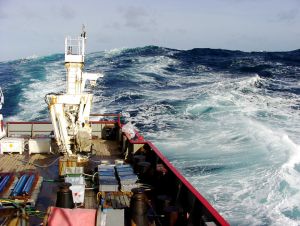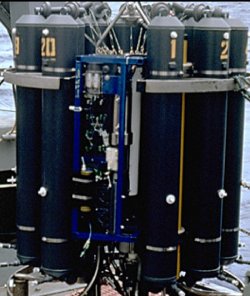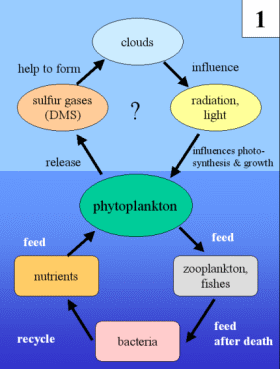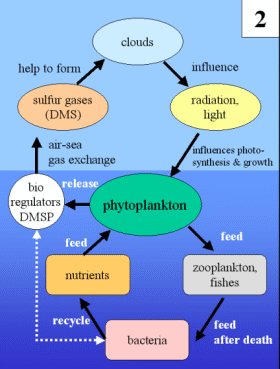 > ACCENT en > Nr 5 Jan. 2006 oceanic sulfur > R: Sulfur gases
> ACCENT en > Nr 5 Jan. 2006 oceanic sulfur > R: Sulfur gases
|
Dimethylsulfide from algaeThe climate impact of phytoplankton and oceanic ecosystems
|
 |
|
1. The sea is not only a wide area of water, but also full of life and in permanent exchange with the air. Photo: Tom Bell
|
|
The forest of the ocean and its smell We know from the trees that they take up carbon dioxide in order to grow and that they releases a certain smell, the smell of the forests. When trees smell, they release organic compounds. The plants in the ocean do the same. They take up carbon dioxide and you can smell the sea if you go to the coast. Certainly you do not smell the water, but certain gases coming from the plants in it.
|
| One of these gases is the organic substance dimethylsulfide (DMS) and it is released by, amongst others, single-celled algae, which are floating in the sea. We call these algae "phytoplankton". Phytoplankton come in a wide variety of shapes. The organisms often belong to the groups of "diatoms" or "dinoflagellates". |
| ||||||||
|
If you would like to see more phytoplankton organisms, please visit the website of Mats Kuylenstierna and Bengt Karlson, where the two pictures are taken from. There is about a factor of 1000 less biomass in the oceans than on land. However, phytoplankton lives only for one week and dies again, taking a lot of nutrients with it to the deeper sea if not eaten up by bacteria. Because of the fast life cycle of phytoplankton there is as much organic material formed in a year in the oceans as on land. See a movie:
|
|
Table: Global sulfur contributions to the air following Rafel Simó (2001) Nowadays humans emit more sulphur compounds to the atmosphere than nature does. But oceanic DMS makes still the largest contribution to the overall sulphur burden in the air, since it stays for a longer time in the atmosphere than human emissions do.
> 90% of the biogenic emissions is oceanic DMS |
|
Does phytoplankton want to regulate the climate? According to Darwin's theories of mutation and selection, a species survives in the long term if it influences the environment in a way which is supportive for its own survival and bad for competitors. Becoming aware of which important impacts the release of DMS has on our climate system, scientists thought that phytoplankton releases DMS in order to regulate the climate over the ocean to its own benefit (CLAW-theory). |
Since also humans change the climate (global warming of air and sea) and change the conditions in the oceans (for example, the discharge of nutrients) the feedback from phytoplankton and DMS cycles is certainly of interest. This was the reason why this phenomenon has been studied in more than 150 research cruises and results have been published in more than 1000 publications. Table:
|
|
|
|
|
What do we know now? We now understand that mechanisms in the marine food network are more complex. DMS in the air is thought to have an impact on climate and this is likely to feedback on phytoplankton growth. However, the situation is not as simple as indicated in scheme 1 below. Phytoplankton does not release DMS immediately. It releases the compound dimethylsulfoniopropionate (DMSP), which is chemically converted into DMS under certain conditions. DMSP does not go to the air. It serves for the communication of marine species (signal compound) and plays a role in osmoregulation. (It stops cells from bursting due to variations in the saltiness of ocean waters.). Moreover, not only phytoplankton but also bacteria play a role in the regulation of DMSP release and conversion into DMS after the death of phytoplankton cells. |
|
|
|
We can now say that many parts of the food network in the oceans and its interactions have to be understood if we would like to explain how exactly the living organisms in the oceans interact with the climate system. It is helpful to know this for many reasons: Humans warm the oceans, humans change the nutrient composition in particular at the coasts, humans add carbon dioxide to the air which makes the oceans acid (carbonic acid) and humans add now even more sulphur to the air than the natural emissions from phytoplankton and volcanoes do together. We have even thought about feeding phytoplankton in the oceans to make it grow and take up more carbon dioxide in order to reduce the greenhouse effect. |
|

